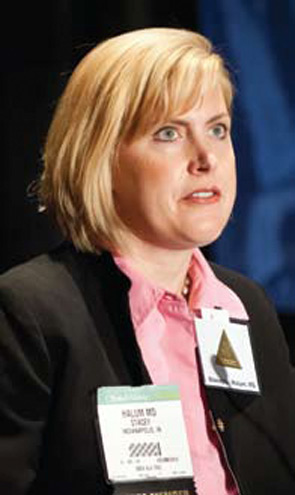CHICAGO — Neurotrophic factors can be introduced using stem cells and, along with the plant alkaloid vincristine, can be used to selectively reinnervate the larynx in rat models, a researcher from Indiana University said here on April 29 at the Annual Meeting of the Triological Society, held as part of the Combined Otolaryngology Spring Meetings.
The study, which received the society’s Fowler Award, introduces a technique that could help patients with recurrent laryngeal nerve injury, according to the author.
Previous studies have shown that recurrent laryngeal nerve injury is followed by a high rate of spontaneous but abnormal reinnervation (Ann Otol Rhinol Laryngol. 2007;116(1):57-65); that vincristine, an alkaloid traditionally used to treat leukemia and some other cancers, can be used to prevent these aberrations (Laryngoscope. 2001;111(5):786-791); and that neurotrophic factor, such as IGF-1, can lead to enhanced reinnervation (Arch Otolaryngol Head Neck Surg. 1999;125:274-279). But this plasmid use is hindered by inefficient and unreliable gene transfers, said Stacey Halum, MD, assistant professor of otolaryngology-head and neck surgery at the Indiana University School of Medicine in Indianapolis. “Our concept was, if we could use stem cells as vectors to deliver neurotrophic factor, we could potentially selectively enhance reinnervation to certain muscles,” Dr. Halum said, “whereas we could use vincristine, in Paniello’s approach, to prevent antagonistic reinnervation. And this may allow us to selectively restore adductor activity.”
Stem Cell Selection
The research group chose to use muscle stem cells, Dr. Halum said, because they could obtain therapeutic quantities with just a small muscle biopsy and for their ease of transduction. Researchers used ciliary neurotrophic factor (CNTF) after finding that 90 percent of cells survived in a muscle stem cell survival assay, compared to 50 percent in a saline group. The researchers then developed a lentivirus to encode the CNTF, finding they could do so with 92 percent efficiency, Dr. Halum said. In a pilot study, they established that vincristine could be used next to stem cells with no adverse effects on the stem cells’ reinnervation effects.
Finally, rat models were divided into five groups, with six in each group: a saline control group; a group with enhanced green fluorescent protein (EGFP)-expressing stem cells injected into the thyroarytenoid (TA) muscle and saline into the posterior cricoarytenoid (PCA) muscle; CNTF-expressing stem cells into the TA and saline into the PCA; EGFP-expressing stem cells into the TA and vincristine into the PCA; and CNTF-expressing stem cells into the TA and vincristine into the PCA.
Results
On videolaryngoscopy after two months, researchers saw only some weak adduction in one CNTF animal. But, on laryngeal electromyography, they saw heightened recruitment scores in the TA muscles in the groups that had received CNTF. And they saw reduced scores in the PCA muscles in those who had received vincristine, as they had hoped.
“At two months, on immunohistochemistry, nearly all of the animals at this point were demonstrating evidence of partial reinnervation of the adductor complex,” Dr. Halum said. At four months, there was less of a difference on laryngeal electromyography, but there was a different story in the immunohistochemistry evaluation; the team found that eight of the stem-cell treated animals had over 66 percent motor endplates with nerve contact.
Applications
The findings could be a launching pad for further use of neurotrophic factor with stem cells, Dr. Halum said. “The study really just serves as a proof of concept,” she said. “It proves that we can have efficient selective delivery of neurotrophic factor with our stem cell vectors. We found a wide variety of spontaneous reinnervation patterns that were enhanced with the stem cell-treated animals.”
Dr. Halum said that in the future, clinicians may be able to use these stem cell techniques to adjust vocal cord position. “In fact, as new investigators are coming out with ways of developing a tissue-engineered larynx, neurotrophic factor-secreting stem cells could readily be incorporated to guide and direct reinnervation,” she said.
Gayle Woodson, MD, professor and chair of otolaryngology-head and neck surgery at Southern Illinois University School of Medicine in Springfield, who has conducted research on reinnervation, said the use of stem cell vectors might help refine reinnervation efforts. “You can always get the nerve to go back to the muscle, but it might not go back to the right muscle,” she said. “You don’t get good movement. Sometimes, the vocal cord is just sitting still or sometimes going in the wrong direction.”
Most groups looking at using neurotrophics, she said, have not considered stem cells. She said she is looking forward to more research being done in this area. “We’re not there yet,” she said. “It’s a lot of the basic science that has to be worked out.”
Randal Paniello, MD, associate professor of otolaryngology-head and neck surgery at Washington University in St. Louis, Mo., said “the work is very exciting and may very well lead to improved outcomes in the future for patients with vocal cord paralysis.”

Leave a Reply